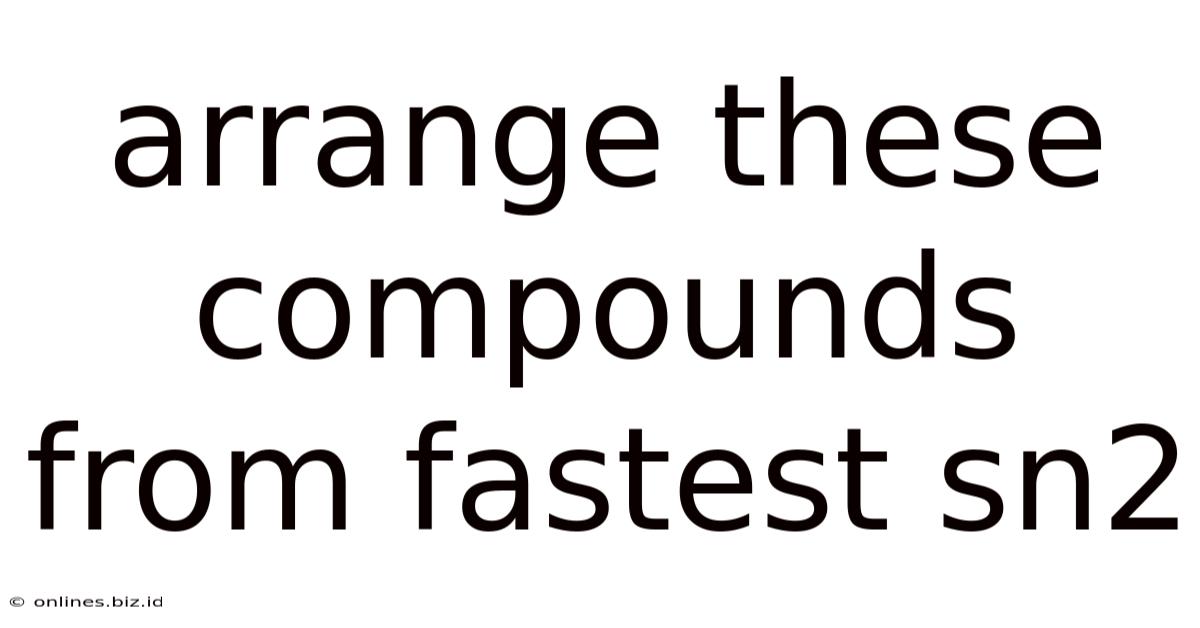Arrange These Compounds From Fastest Sn2
Onlines
May 11, 2025 · 4 min read

Table of Contents
Arranging Compounds by SN2 Reaction Rate: A Comprehensive Guide
The SN2 (bimolecular nucleophilic substitution) reaction is a cornerstone of organic chemistry, representing a crucial pathway for substitution reactions. Understanding the factors influencing its rate is vital for predicting reaction outcomes and designing synthetic strategies. This article delves deep into the intricacies of SN2 reactions, explaining the key determinants of reaction rate and providing a framework for arranging compounds based on their SN2 reactivity.
Understanding the SN2 Mechanism
The SN2 reaction involves a concerted mechanism, meaning the bond breaking and bond formation occur simultaneously in a single transition state. A nucleophile (Nu⁻), an electron-rich species, attacks the electrophilic carbon atom from the backside, opposite to the leaving group (LG). This backside attack leads to inversion of configuration at the stereocenter. The rate of the reaction depends on the concentration of both the substrate (alkyl halide or similar) and the nucleophile:
Rate = k[substrate][nucleophile]
This second-order kinetics is the defining characteristic of the SN2 reaction.
Factors Affecting SN2 Reaction Rate
Several factors significantly impact the rate of an SN2 reaction. These include:
1. Substrate Structure:
-
Methyl Halides (CH₃X): These are the most reactive substrates in SN2 reactions due to the absence of steric hindrance. The nucleophile has unimpeded access to the electrophilic carbon.
-
Primary Halides (RCH₂X): These are also relatively reactive, although slightly less so than methyl halides. Minimal steric hindrance is present.
-
Secondary Halides (R₂CHX): Steric hindrance significantly reduces the reaction rate compared to primary halides. The bulky alkyl groups hinder the backside attack by the nucleophile.
-
Tertiary Halides (R₃CX): These are essentially unreactive towards SN2 reactions. The high degree of steric hindrance completely blocks the nucleophile's approach to the electrophilic carbon. Tertiary halides overwhelmingly favor SN1 reactions.
2. Leaving Group Ability:
The leaving group's ability to stabilize the negative charge it acquires after leaving significantly impacts the reaction rate. Good leaving groups are weak bases, meaning they can readily accept the negative charge without significant destabilization. Generally, the order of leaving group ability is:
I⁻ > Br⁻ > Cl⁻ > F⁻
This trend reflects the increasing basicity (and decreasing stability as anions) from iodide to fluoride. Good leaving groups facilitate the SN2 reaction by stabilizing the transition state.
3. Nucleophile Strength:
Strong nucleophiles, possessing a high electron density and a readily available lone pair, react faster in SN2 reactions. Factors influencing nucleophile strength include:
-
Charge: Negatively charged nucleophiles are generally stronger than neutral nucleophiles.
-
Electronegativity: Less electronegative atoms are better nucleophiles as they can more easily donate electrons.
-
Solvent: Polar aprotic solvents (e.g., DMSO, DMF, acetone) enhance SN2 reactions by stabilizing the nucleophile without solvating it excessively, keeping it reactive. Protic solvents (e.g., water, alcohols) can hinder SN2 reactions by solvating the nucleophile, reducing its reactivity.
4. Solvent Effects:
As mentioned above, the solvent plays a critical role. Polar aprotic solvents are preferred for SN2 reactions because they effectively solvate the cationic portion of the transition state, reducing its energy, and thus lowering the activation energy of the reaction. Conversely, polar protic solvents strongly solvate the nucleophile, reducing its reactivity and slowing down the reaction.
Arranging Compounds Based on SN2 Reactivity
To arrange compounds in order of decreasing SN2 reactivity, consider the combined effect of substrate structure and leaving group ability. A compound with a methyl substrate and a good leaving group (e.g., iodide) will react much faster than a compound with a tertiary substrate and a poor leaving group (e.g., fluoride).
Example:
Let's consider the following compounds:
- CH₃I
- CH₃CH₂Br
- (CH₃)₂CHCl
- (CH₃)₃CI
- CH₃CH₂CH₂F
Arranging them in order of decreasing SN2 reactivity:
- CH₃I: Methyl substrate with the best leaving group (I⁻). Fastest SN2 reaction.
- CH₃CH₂Br: Primary substrate with a good leaving group (Br⁻). Faster than secondary or tertiary substrates.
- CH₃CH₂CH₂F: Primary substrate but with a poor leaving group (F⁻). Slower than CH3CH2Br.
- (CH₃)₂CHCl: Secondary substrate with a relatively decent leaving group (Cl⁻), but steric hindrance slows the reaction considerably.
- (CH₃)₃CI: Tertiary substrate. Essentially unreactive towards SN2 reactions due to overwhelming steric hindrance.
Further Considerations:
-
Ambident Nucleophiles: Nucleophiles with multiple nucleophilic sites (e.g., CN⁻, which can attack through either C or N) may exhibit different reactivity depending on the substrate and reaction conditions.
-
Intramolecular SN2 Reactions: These reactions, where the nucleophile and electrophile are part of the same molecule, often proceed faster than intermolecular SN2 reactions due to proximity effects.
-
Competition with other reaction pathways: Remember that SN2 reactions often compete with other mechanisms, particularly SN1 and elimination reactions (E1 and E2). The relative rates depend heavily on the specific reactants and conditions.
-
Specific examples requiring detailed analysis: Complex molecules may require a detailed analysis of steric hindrance and electronic effects to predict their relative SN2 reactivity accurately.
Conclusion
Predicting the rate of SN2 reactions requires careful consideration of various factors. Substrate structure, leaving group ability, nucleophile strength, and solvent effects all play crucial roles. By understanding these factors and their interplay, you can effectively arrange compounds in order of their SN2 reactivity and design synthetic strategies that favor or avoid this crucial reaction pathway. This comprehensive understanding is essential for success in organic chemistry synthesis and research.
Latest Posts
Latest Posts
-
Which Structure Below Represents A Ketone
May 12, 2025
-
What Is The Most Important Factor Driving Metamorphism
May 12, 2025
-
Label The Organelles In The Composite Cell
May 12, 2025
-
Which Of The Following Best Defines Economies Of Scope
May 12, 2025
-
Companies Can Use Combination Strategies With Technology To
May 12, 2025
Related Post
Thank you for visiting our website which covers about Arrange These Compounds From Fastest Sn2 . We hope the information provided has been useful to you. Feel free to contact us if you have any questions or need further assistance. See you next time and don't miss to bookmark.